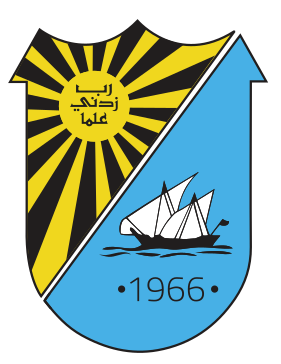Bader Albdaiwi
Professor of Computer Science
2498-5341
Kuwait University
College of Science
Computer Science Department,
P.O. Box 5969
Safat -13060
College of Science
Computer Science Department,
P.O. Box 5969
Safat -13060
Education:
Ph.D. in Computer Science
Oregon State University, USA1997
M.S. in Computer Science
University of Colorado-Boulder, USA1995
B.S. in Computer Science
Kuwait University, Kuwait1992
Interests and Research:
- Interconnection Networks
- Parallel Computing
Publications:
- Hussain, Z. A., AboElFotoh, H. M. F., & AlBdaiwi, B. F. (2022). Independent spanning trees in Eisenstein-Jacobi networks. J. Supercomput., 78(10), 12114–12135. doi:10.1007/s11227-022-04351-4
- Hussain, Z. A., AboElFotoh, H. M. F., & AlBdaiwi, B. F. (2021). Independent Spanning Trees in Eisenstein-Jacobi Networks. CoRR, abs/2101.09797. Retrieved from https://arxiv.org/abs/2101.09797
- Hussain, Z. A., AlBdaiwi, B. F., & Cerný, A. (2017a). Node-independent spanning trees in Gaussian networks. J. Parallel Distributed Comput., 109, 324–332. doi:10.1016/j.jpdc.2017.06.018
- AlBdaiwi, B. F., & AboElFotoh, H. M. F. (2017). A GPU-based genetic algorithm for the p-median problem. J. Supercomput., 73(10), 4221–4244. doi:10.1007/s11227-017-2006-x
- Hussain, Z. A., AlBdaiwi, B. F., & Cerný, A. (2017b). Node-Independent Spanning Trees in Gaussian Networks. CoRR, abs/1701.02991. Retrieved from http://arxiv.org/abs/1701.02991
- AlBdaiwi, B. F., Hussain, Z. A., Cerný, A., & Aldred, R. E. L. (2016a). Edge-disjoint node-independent spanning trees in dense Gaussian networks. J. Supercomput., 72(12), 4718–4736. doi:10.1007/s11227-016-1768-x
- AlBdaiwi, B. F., Hussain, Z. A., Cerný, A., & Aldred, R. E. L. (2016b). Edge-Disjoint Node-Independent Spanning Trees in Dense Gaussian Networks. CoRR, abs/1601.06915. Retrieved from http://arxiv.org/abs/1601.06915
- AlEnezi, Q., AboElFotoh, H. M. F., AlBdaiwi, B. F., & AlMulla, M. A. (2016). Heuristics for the Variable Sized Bin Packing Problem Using a Hybrid P-System and CUDA Architecture. CoRR, abs/1602.08735. Retrieved from http://arxiv.org/abs/1602.08735
- AlBdaiwi, B. F. (2016). On the Number of Cycles in a Graph. CoRR, abs/1603.01807. Retrieved from http://arxiv.org/abs/1603.01807
- AlBdaiwi, B. F., & AboElFotoh, H. M. F. (2016). A GPU-Based Genetic Algorithm for the P-Median Problem. CoRR, abs/1610.10061. Retrieved from http://arxiv.org/abs/1610.10061
- AlBdaiwi, B. F., & Thalheim, B. (2015). Revisiting the Definition of the Relational Tuple Calculus. In T. Morzy, P. Valduriez, & L. Bellatreche (Eds.), New Trends in Databases and Information Systems - ADBIS 2015 Short Papers and Workshops, BigDap, DCSA, GID, MEBIS, OAIS, SW4CH, WISARD, Poitiers, France, September 8-11, 2015. Proceedings (pp. 3–11). doi:10.1007/978-3-319-23201-0_1
- AlBdaiwi, B. F., Noack, R., & Thalheim, B. (2014). Pattern-Based Conceptual Data Modelling. In B. Thalheim, H. Jaakkola, Y. Kiyoki, & N. Yoshida (Eds.), Information Modelling and Knowledge Bases XXVI, 24th International Conference on Information Modelling and Knowledge Bases (EJC 2014), Kiel, Germany, June 3-6, 2014 (pp. 1–20). doi:10.3233/978-1-61499-472-5-1
- Karaata, M. H., Sinanoglu, O., & AlBdaiwi, B. F. (2012). An Optimal Inherently Stabilizing 2-Neighborhood Crash Resilient Protocol for Secure and Reliable Routing in Hypercube Networks. Comput. J., 55(5), 578–589. doi:10.1093/comjnl/bxr095
- Horák, P., & AlBdaiwi, B. F. (2012b). Non-periodic Tilings of (R) n by Crosses. Discret. Comput. Geom., 47(1), 1–16. doi:10.1007/s00454-011-9373-5
- Horák, P., & AlBdaiwi, B. F. (2012a). Diameter Perfect Lee Codes. IEEE Trans. Inf. Theory, 58(8), 5490–5499. doi:10.1109/TIT.2012.2196257
- AlBdaiwi, B. F., Ghosh, D., & Goldengorin, B. (2011). Data aggregation for emphp-median problems. J. Comb. Optim., 21(3), 348–363. doi:10.1007/s10878-009-9251-8
- Horák, P., & AlBdaiwi, B. F. (2011). Diameter Perfect Lee Codes. CoRR, abs/1109.3475. Retrieved from http://arxiv.org/abs/1109.3475
- Sinanoglu, O., Karaata, M. H., & AlBdaiwi, B. F. (2010). An Inherently Stabilizing Algorithm for Node-To-Node Routing over All Shortest Node-Disjoint Paths in Hypercube Networks. IEEE Trans. Computers, 59(7), 995–999. doi:10.1109/TC.2010.76
- Niepel, L., Cerný, A., & AlBdaiwi, B. F. (2009). Efficient domination in directed tori and the Vizing’s conjecture for directed graphs. Ars Comb., 91.
- AlBdaiwi, B. F., Goldengorin, B., & Sierksma, G. (2009). Equivalent instances of the simple plant location problem. Comput. Math. Appl., 57(5), 812–820. doi:10.1016/j.camwa.2008.10.081
- AlBdaiwi, B. F., Horák, P., & Milazzo, L. (2009). Enumerating and decoding perfect linear Lee codes. Des. Codes Cryptogr., 52(2), 155–162. doi:10.1007/s10623-009-9273-3
- Anantha, M., Bose, B., & AlBdaiwi, B. F. (2007b). Mixed-Radix Gray Codes in Lee Metric. IEEE Trans. Computers, 56(10), 1297–1307. doi:10.1109/TC.2007.1083
- Anantha, M., Bose, B., & AlBdaiwi, B. F. (2007a). Mixed Radix Gray Codes and Edge Disjoint Hamiltonian Cycles in Toroidal Networks. IEEE International Symposium on Information Theory, ISIT 2007, Nice, France, June 24-29, 2007, 1991–1995. doi:10.1109/ISIT.2007.4557513
- Horák, P., & AlBdaiwi, B. F. (2006). Fast decoding of quasi-perfect Lee distance codes. Des. Codes Cryptogr., 40(3), 357–367. doi:10.1007/s10623-006-0025-3
- AlBdaiwi, B. F., & Bose, B. (2005). Quasi-perfect resource placements for two-dimensional toroidal networks. J. Parallel Distributed Comput., 65(7), 815–831. doi:10.1016/j.jpdc.2005.02.005
- Bae, M. M., AlBdaiwi, B. F., & Bose, B. (2004). Edge-disjoint Hamiltonian cycles in two-dimensional torus. Int. J. Math. Math. Sci., 2004(25), 1299–1308. doi:10.1155/S0161171204307325
- AlBdaiwi, B. F., & Livingston, M. L. (2004). Perfect Distance-d Placements in 2D Toroidal Networks. J. Supercomput., 29(1), 45–57. doi:10.1023/B:SUPE.0000022572.95414.27
- AlBdaiwi, B. F., & Bose, B. (2003a). On resource placements in 3D tori. J. Parallel Distributed Comput., 63(9), 838–845. doi:10.1016/S0743-7315(03)00122-9
- AlBdaiwi, B. F., & Bose, B. (2003b). Quasi-perfect Lee distance codes. IEEE Trans. Inf. Theory, 49(6), 1535–1539. doi:10.1109/TIT.2003.811922

